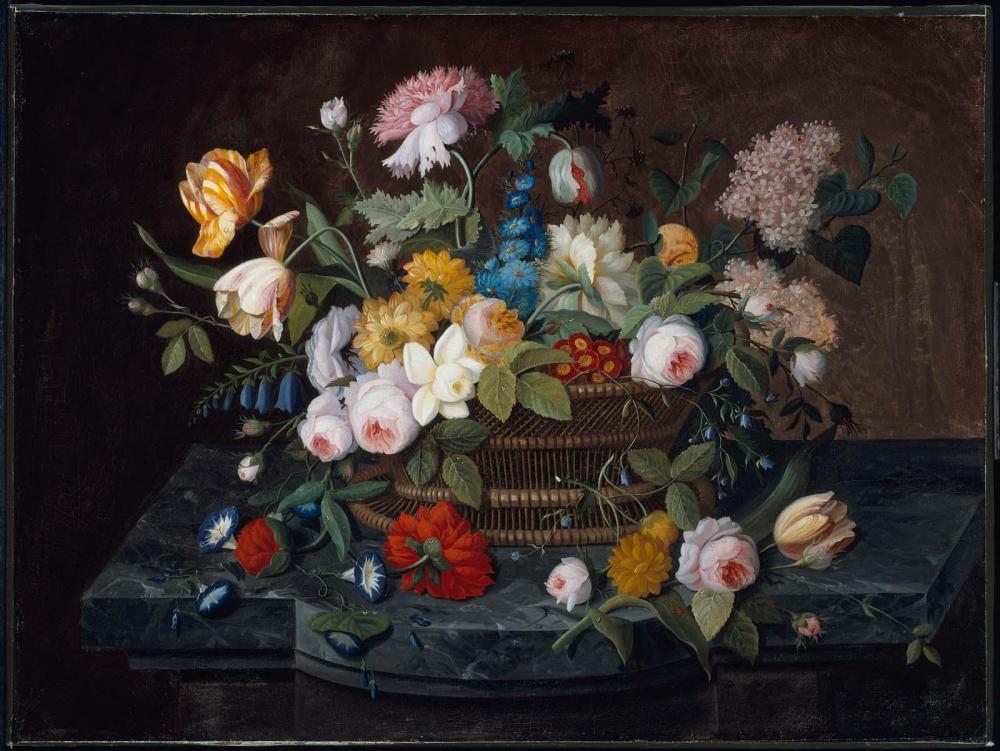Advanced Search 

Still Life-Flowers in a Basket
Severin Roesen (American (born Prussia), 1816–1876 or after)
1850s
Medium/Technique
Oil on canvas
Dimensions
76.2 x 102.23 cm (30 x 40 1/4 in.)
Credit Line
M. and M. Karolik Fund
Accession Number69.1228
CollectionsAmericas
ClassificationsPaintings
Roesen painted about three to four hundred still lifes during his career, but little is known of his life. Evidence suggests that he trained as a porcelain painter in Germany and that he exhibited a still life at an art club in Cologne in 1847 before he fled Germany’s political turmoil in 1848. For the next nine years, he lived, exhibited, and developed a following among collectors and artists in New York. In 1857, apparently prompted by a downturn in the New York art market (the result of trouble in the city’s economy), he left for Pennsylvania, eventually settling in Williamsport in 1862. Pennsylvania offered not only a sizeable German community but also potential clients who had prospered by the booming lumber industry. It appears that Roesen remained in Williamsport until 1872. What happened to him after that remains a mystery, but reports that he returned to New York or that he died in a Philadelphia almshouse have proven unfounded.
According to anecdotal evidence, Roesen may also have painted portraits, but only his still lifes have been identified. These works depict flowers and fruit, and combinations thereof, usually placed on a white or dark marble slab against a plain background. His training as a porcelain painter probably influenced his approach to still life, but his work is clearly an extension of the fruit and flower pieces of late-seventeenth- and early-eighteenth-century Dutch artists such as Jan van Huysum [89.503], Rachel Ruysch, and Maria van Oosterwijck. Roesen may have known these Dutch paintings at first hand or through the work of Jacob Preyer, who kept the tradition of still-life painting alive in nineteenth-century Düsseldorf.
Roesen’s work defies a chronology. He dated only about two dozen of his paintings, and these all include similar objects. It is unlikely that Roesen painted directly from a model: it is difficult, even impossible, to replicate his arrangements with actual objects and he often combined flowers and fruits that bloomed at different times of the year. Roesen may instead have used popular prints or botanical drawings, or studies that he himself had made, as models for his arrangements. [1]
It is unsurprising that Roesen’s work attracted buyers and many imitators, since the ground had been laid in the United States for art such as his. Dutch still lifes had been exhibited and actively collected in New York, Philadelphia, and Boston, and the precise drawing and elaborate compositions of the Düsseldorf school had shaped the taste and style of American collectors and painters. Moreover, Roesen’s images of natural abundance probably struck a chord with the growing American middle class, who might well have understood them as emblems of their own prosperity, plenitude, and well-being.
Notes
1. William H. Gerdts, Painters of the Humble Truth: Masterpieces of American Still Life, 1801–1939, exh. cat. (Columbia, Mo.: Philbrook Art Center and University of Missouri Press, 1981), 87–89.
This text was adapted from Karyn Esielonis et al., Still-Life Painting in the Museum of Fine Arts, Boston, exh. cat.(Boston: Museum of Fine Arts, 1994).
According to anecdotal evidence, Roesen may also have painted portraits, but only his still lifes have been identified. These works depict flowers and fruit, and combinations thereof, usually placed on a white or dark marble slab against a plain background. His training as a porcelain painter probably influenced his approach to still life, but his work is clearly an extension of the fruit and flower pieces of late-seventeenth- and early-eighteenth-century Dutch artists such as Jan van Huysum [89.503], Rachel Ruysch, and Maria van Oosterwijck. Roesen may have known these Dutch paintings at first hand or through the work of Jacob Preyer, who kept the tradition of still-life painting alive in nineteenth-century Düsseldorf.
Roesen’s work defies a chronology. He dated only about two dozen of his paintings, and these all include similar objects. It is unlikely that Roesen painted directly from a model: it is difficult, even impossible, to replicate his arrangements with actual objects and he often combined flowers and fruits that bloomed at different times of the year. Roesen may instead have used popular prints or botanical drawings, or studies that he himself had made, as models for his arrangements. [1]
It is unsurprising that Roesen’s work attracted buyers and many imitators, since the ground had been laid in the United States for art such as his. Dutch still lifes had been exhibited and actively collected in New York, Philadelphia, and Boston, and the precise drawing and elaborate compositions of the Düsseldorf school had shaped the taste and style of American collectors and painters. Moreover, Roesen’s images of natural abundance probably struck a chord with the growing American middle class, who might well have understood them as emblems of their own prosperity, plenitude, and well-being.
Notes
1. William H. Gerdts, Painters of the Humble Truth: Masterpieces of American Still Life, 1801–1939, exh. cat. (Columbia, Mo.: Philbrook Art Center and University of Missouri Press, 1981), 87–89.
This text was adapted from Karyn Esielonis et al., Still-Life Painting in the Museum of Fine Arts, Boston, exh. cat.(Boston: Museum of Fine Arts, 1994).
Provenance1969, with Vose Galleries, Boston; 1969, sold by Vose Galleries to the MFA. (Accession Date: November 19, 1969)
